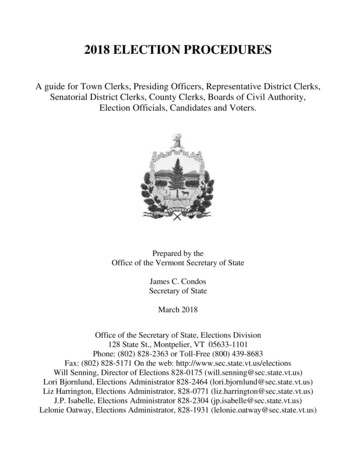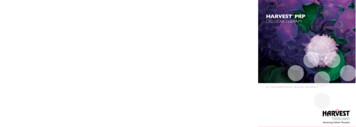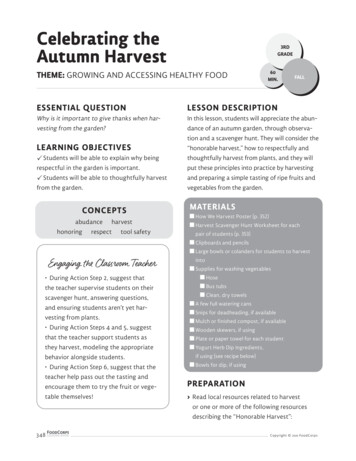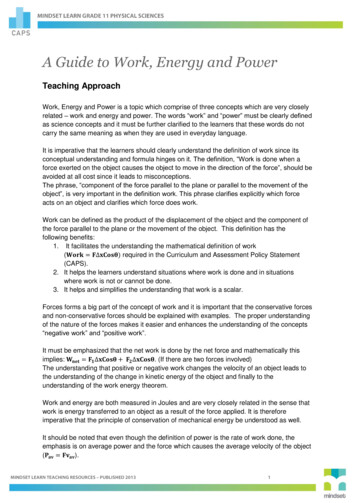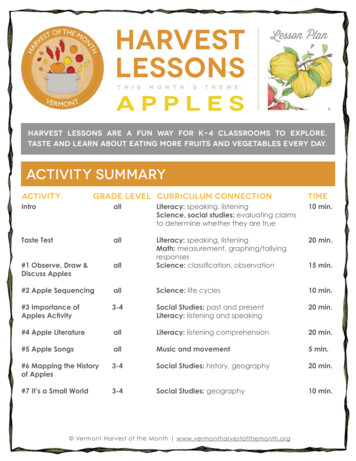
Transcription
HARVESTLESSONST H I SM O N T H ’ SLesson PlanT H E M E :APPLESHARVEST LESSONS ARE A FUN WAY FOR K-4 CLASSROOMS TO EXPLORE,TASTE AND LEARN ABOUT EATING MORE FRUITS AND VEGETABLES EVERY DAY.ACTIVITY SUMMARYACTIVITYGRADE LEVEL CURRICULUM CONNECTIONTIMEIntroallLiteracy: speaking, listeningScience, social studies: evaluating claimsto determine whether they are true10 min.Taste Testall20 min.#1 Observe, Draw &Discuss ApplesallLiteracy: speaking, listeningMath: measurement, graphing/tallyingresponsesScience: classification, observation#2 Apple SequencingallScience: life cycles10 min.#3 Importance ofApples Activity3-4Social Studies: past and presentLiteracy: listening and speaking20 min.#4 Apple LiteratureallLiteracy: listening comprehension20 min.#5 Apple SongsallMusic and movement5 min.#6 Mapping the Historyof Apples3-4Social Studies: history, geography20 min.#7 It’s a Small World3-4Social Studies: geography10 min. Vermont Harvest of the Month www.vermontharvestofthemonth.org15 min.
HARVEST LESSONS APPLES PAGE 2INTRODUCTION (10 MINUTES) ALL GRADESTRUE OR FALSE?Introduce or reintroduce yourself to the class. Begin with a fun interactive true or falseactivity. When a statement is true, students will stand up. When they believe a statement isfalse, they will sit down.1. The very first apple trees grew in North America.False! Apple trees originated in Kazakhstan, a small country near Russia.Then people brought apples to China, and then to Europe, and then when Europeanscame to North America in the 1600s, they brought apples with them.2. There once were 14,000 different kinds of apples growing in the United States.True! In 1905 the U.S. Department of Agriculture published a 400 page book listing more than14,000 distinct types of apples grown in the U.S. Now there are a lot fewer kinds of applesbecause fewer people are farmers, and growers favor sweet varieties for eating, rather thansome older more tart varieties for cider.3. You can only eat local apples in the fall.False! If kept at a cool temperature with the right amount of moisture, apples can keep fora long time! You can find Vermont & New Hampshire apples at some grocery stores all yearlong! If your grocery store doesn’t have local apples all year, you can make apples intoapplesauce and can it, and eat local apples all year that way.4. Johnny Appleseed was a real person.True! His real name was John Chapman, and he brought hundreds of appleseeds west. He started several different tree nurseries, and sold apple trees to other whitesettlers who were heading west.5. Red delicious apples are the most tasty kind.False! Most people think they are one of the least yummy kinds of apples. They’re grownbecause they look very beautiful and delicious, and are very hard so they aren’t easilybruised while traveling across the country in trucks to grocery stores.6. Apples are the healthiest fruit because “An apple a day keeps the doctor away.”False! Apples are very healthy, because they have lots of Vitamin C, and lots of fiber, whichhelps your digestive system do its job, as well as some phosphorous and some potassiumwhich are both important nutrients. But other fruits have more types of vitamins and nutrients,and a higher amount per serving. The saying “An apple a day keeps the doctor away” wasinvented by apple growers in the early 1900s because they wanted people to buy moreapples. Vermont Harvest of the Month www.vermontharvestofthemonth.org
HARVEST LESSONS APPLES PAGE 3(introduction, continued)Ask these focusing questions throughout the lesson: What is the part of the plant that we eat? What color is it? How does it help our body? Where does it originate?HEIRLOOM APPLE TASTE TEST (20 minutes)PREPARATIONGather varieties of apples that grow locally. Try to get varieties that show the diversity ofcolors and sizes available. Bring in an apple slicer or knife and cutting board, careful to keepsharp items away from children.PROCEDUREAsk, “Is every apple the same?” and then explain that there are different kinds of apples,and that “You’re going to see if you can taste the difference!” Say the name of a variety,and write it on the board. Then have each student taste it. Ask them to describe what ittastes like, and record the words they say. For younger kids, you might need to give themsome examples of words to use (sweet, sour, tart, tangy, crunchy, soft, mushy). Do this forevery variety. Then ask the class to vote on their favorite. Record the votes in a chart withtallies.ACTIVITY #1(15 MINUTES)ALL GRADESOBSERVE & DRAW APPLESMATERIALS Journal or paper Colored pencils Apples (whole and sliced)PROCEDUREHave students draw and label the parts of an apple. Can they label skin, seeds? Afterconducting an apple taste test they can write in their journals about their experience. Whatwas their favorite variety? Did they learn something new about apples today? Vermont Harvest of the Month www.vermontharvestofthemonth.org
HARVEST LESSONS APPLES PAGE 4ACTIVITY #2(10 MINUTES)ALL GRADESAPPLE SEQUENCINGAsk students “How do we get apples anyways? Where do they come from?” Take a fewresponses. Then explain that there are a lot of steps that go into growing apples. Withyounger students (K-2), go over what each card represents (out of order though).Explain that students will try to put them in the right order. Give a deck to each student orpair of students, and give them 5 minutes to arrange them. Then ask a few students or pairsto share the sequence they came up with. Find and discuss the correct order as a class.ACTIVITY #3(20 MINUTES)GRADES 3-4IMPORTANCE OF APPLESHand out a Venn diagram template (see appendix) to each student, and explain how aVenn diagram works. Draw your own Venn diagram on the board. “We’re going to use ourVenn diagram to compare how apples used to be important here 100 or 200 years ago, andhow they are important now.”Label one circle “Past,” and one circle “Present” or “Today.” Have students brainstormreasons apples are and were important. Use props (see attached “List of Apple Props” forideas) to prompt them. Guide them to record the reasons in the appropriate part of theirVenn diagram (ask them where a reason should go, correct them if necessary, record thereason in one or two words on the board, then give them a little time to record it in their owndiagram). When you run out of reasons or time, review the diagram and what it means withthe class. You can follow this activity with a journal activity.SUGGESTED PROPS Fresh apple (or plastic model)Empty vitamin bottles for:Vitamin CPotassiumFiberBottle of cider vinegar (empty or full)Jug of cider (empty or full)Applesauce container (jar, package, cup)Jelly jar or pectin packetPiece of firewoodPhoto of a rocking chair Vermont Harvest of the Month www.vermontharvestofthemonth.org
HARVEST LESSONS APPLES PAGE 5(activity #3 continued) Pie pan or apple pie toy or photo Picture, figurine or stuffed animal of some animals that eats apples and/or apple leavesor saplings, such as:o white tailed deero skunko raccoono birds (ruffed grouse, cedar waxwings, woodpeckers, yellow-belliedsapsuckers, blue-jays, crows and many more)o caterpillars (viceroy butterfly larva, eastern tent caterpillar and many manymore)o cowo horseo squirrelo mouseo black bearo foxWrite in journal about why apples are important (10 min): Explain at least one reason whylocal apples are or were important, and draw a picture that illustrates that reason. Forsecond grade and up, ask for full sentences. For third and fourth graders, ask for one reasonthey were important in the past and one reason they are important now. Remind studentsthat they can use their Venn diagram to help with what to write.ACTIVITY #4(20 MINUTES)ALL GRADESAPPLE LITERATUREThere is an abundance of books about this popular fruit. Here’s a list of favorites fromVermont FEED. You may have a favorite of your own. Amazing Apple Book (as a teacher’s resource) My Apple by Kay Davies and Wendy Oldfield (fabulous photos) The Life and Times of the Apple by Charles Micucci An Apple Tree Through the Year by Claudia Schneiper The Seasons of Arnold’s Apple by Gail Gibbons How Do Apples Grow by Betsy Maestro Albert’s Field Trip by Leslie Tryon The Apple by Joy Cowley (The Wright Group) The Story of Johnny Appleseed by Aliki Apple Picking Time by Michele Benoit Slawson Applesauce by Shirley Kurtz How to Make an Apple Pie and See the World by Marjorie Priceman The Apple Pie Tree by Zoe Hall Vermont Harvest of the Month www.vermontharvestofthemonth.org
HARVEST LESSONS APPLES PAGE 6(activity #4 continued) Apple Picking Time by Michele B. Slawson The Life and Times of the Apple by Charles Micucci Ten Apples Up on Top by Theo LeSieg (Dr. Seuss) Johnny Appleseed by Steven KelloggACTIVITY #5(5 MINUTES) ALL GRADESSING APPLE SONGSSing these fun apple songs, to the tune of some familiar children’s songs.DO YOU KNOW THE APPLE MAN?(sung to the tune of The Muffin Man)Oh, do you know the apple manThe apple manThe apple manOh, do you know the apple manWho loves to grow his treesOh, he has a great big smileA great big smileA great big smileOh, he has a great big smileAnd loves to grow his treesOh, he has a big red appleA big red appleA big red appleOh, he has a big red appleTo bake a pie for me(You can substitute other products for the pie,such as applesauce, apple muffin, apple crisp)HAVE YOU EVER SEEN AN APPLE(to the tune of Have You Ever Seen a Lassie)Have you ever seen an apple,An apple, an appleHave you ever seen an appleThat grows on a tree?A red one, a yellow oneA green one, a golden oneHave you ever seen an appleThat grows on a tree?APPLES, APPLES(to the tune of Twinkle, Twinkle, Little Star)Apples juicy, apples round,On the tree or on the ground.Apples yellow, apples red,Apple pie and juice and bread!Apples crunchy, apples sweet,Apples are so good to eatAPPLE(to the tune of BINGO)I know a fruit that grows on trees,And apple is its name, oh!A-P-P-L-EA-P-P-L-EA-P-P-L-EAnd apple is its name, oh!In summer and in early fall,It’s time to pick an apple! (repeat A-P-P-L-E)It may be sweet or may be tart,It’s red or green or yellow! (repeat A-P-P-L-E)A MacIntosh or Granny Smith,A Winesap or Delicious! (repeat A-P-P-L-E)Make applesauce or apple juiceOr apple pie with apples! (repeat A-P-P-L-E) Vermont Harvest of the Month www.vermontharvestofthemonth.org
HARVEST LESSONS APPLES PAGE 7ACTIVITY #6(20 MINUTES)GRADES 3-4MAP THE HISTORY OF APPLESMATERIALS A copy for each student of Harvest Lessons map (see appendix)One copy of the Apple Timeline & Mapping Directions to project, or one copy per studentAn atlas for each student or pair of studentsColored pencilsPROCEDUREPass out copies of the Harvest Lessons map to each student. Project or pass out the AppleTimeline & Mapping Directions. Instruct students to follow the directions to map the history ofapples!ACTIVITY #7(10 MINUTES)GRADES 3-4IT’S A SMALL WORLDSee attached sheet for background information and instructions on this activity from HealthyFood from Healthy Soils, which uses apples to demonstrate the finite nature of earth’sresources.OTHER IDEAS See attached background information on some of the more complicated parts of applereproduction – pollination, grafting, and the difference between an heirloom and ahybrid Extend the heirloom apple taste test into a version of Shelburne Farms’ Posy Poetry activity Ask students to invent a variety of apple – they will name it, describe why it’s worthgrowing (e.g., it tastes a little like strawberries, it lasts a long time, it is a beautiful pinkcolor), and make an illustration of their imaginary apple variety Plan a field trip to an apple orchardCLOSINGSAcKNOWLEDGeMENTSThe following people contributed to developing this lesson plan: Chloe Powell, Aurora Coon,Cat Buxton, Karen Ganey and Kaitlin Haskins.APPENDIX SEE WORKSHEETS THAT FOLLOW Vermont Harvest of the Month www.vermontharvestofthemonth.org
Activity #2 Vermont Harvest of the Month www.vermontharvestofthemonth.org
Activity #2 Vermont Harvest of the Month www.vermontharvestofthemonth.org
Activity #3 Vermont Harvest of the Month www.vermontharvestofthemonth.org
CREATING AN APPLE TIMELINEActivity #6Not everyone agrees where apples first came from, but most scientists think it wassomewhere in Central Asia, in a mountain range called the Dzungarian Alps. Thesemountains separate the countries that are now known as Kazakhstan, Kyrgyzstan, and China.#1: On your map, color red the area where Kazakhstan, Dyrgyzstan, and China meet.By 1500 BC, there are records showing the sale of apples in Mesopotamia. Mesopotamiais an ancient civilization that no longer exists. What used to be Mesopotamia is now thecountries of Iraq, Kuwait, Iran, Syria, and Turkey.#2: On your map, shade in yellow the countries of Iraq, Kuwait, Iran, Syria, and Turkey toshow where Mesopotamia was. Then, draw an arrow from the area you shaded red to thearea you shaded yellow.In 1300 BC, an Egyptian pharaoh ordered apples to be grown around the Nile River.#3: On your map, shade in Egypt as blue.By 328 BC, Alexander the Great, the king of Macedonia, brought apples from Kazakhstanto his kingdom in Macedonia. Macedonia is still a country today but is smaller than whenAlexander the Great ruled it.#4: On your map, shade in orange the country of Macedonia and also the top Northern partof Greece to show Alexander the Great’s huge kingdom. Next, draw an arrow from whereyou shaded red to Macedonia to show how the apples travelled.By 100 AD, apples had spread throughout Europe, as far North as Germany!#5: On your map, shade Europe in green as far North as Germany.Apples finally came to North America in 1625 when the first colonists from Europe came over.The first apple orchards were planted in Boston.#6: On your map, draw a star where Boston is to show the first apple in North America. Then,draw an arrow from Europe to Boston to show how apples traveled over the ocean to get toAmerica.Johnny Appleseed was a real historical figure, a man named John Chapman who plantednurseries as he travelled through Pennsylvania, Ohio, Indiana, Illinois, and Northern Virginiastarting in the 1790s.#7: Draw a path between these states.Today the largest producers of Apples are China, the United States, and Turkey.#8: Label these countries. Vermont Harvest of the Month www.vermontharvestofthemonth.org
THIS MONTH’S FOOD:Activity #6 Vermont Harvest of the Month www.vermontharvestofthemonth.org
Activity #7
In 1905 the U.S. Department of Agriculture published a 400 page book listing more than 14,000 distinct types of apples grown in the U.S. Now there are a lot fewer kinds of apples because fewer people are farmers, and growers favor sweet varieties for eating, rather than some



